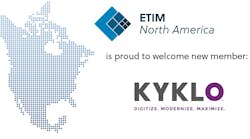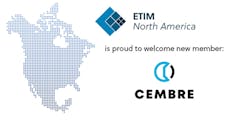Responding to advancing technologies and the need to trim travel budgets, the electrical industry is now experiencing a surge in Webcasting.
GE Lighting, Cleveland; The National Association of Wholesaler-Distributors (NAW), Washington; and Vanguard Distribution Group have all used Webcasting or Web conferencing technologies in recent months.
Marshall Eubanks, chief technical officer for Multicast Technology, Wash., said Webcasting and Web conferencing are all about saving your business money.
“I tell people, most of this is really about expense,” he said. “It's lowering the cost of doing business.”
Not just for annual reports and one-way communication, applications of Webcasting are found throughout all areas of business, from training to sales.
NAW recently launched a major Webcasting initiative with its broadcast of the Distribution Research and Education Foundation (DREF) study, “Facing the Forces of Change: Future Scenarios for Wholesale Distribution.”
NAW held the Webcast on Oct. 10. The group said more than 600 distribution industry personnel tuned in. Attendees could ask questions and participate in online surveys during the broadcast.
Rather than have all of its distributors and representatives converge on one location for a marketing or product training meeting, GE Lighting is using Webcasting for its “Mondays at Noon” series of presentations.
“It's great for training,” said Greg Dore, manager of marketing support for GE Lighting. “It's also good for delivery of marketing programs to key distributor partners, where we can have a Web-based planning session with them that's interactive. We can talk about our marketing support materials, and they can talk about their needs. Using Webcasting technology, we're able to have a meaningful dialogue between our distributor partners and ourselves.”
GE Lighting has broadcast its “Mondays at Noon” presentations since September. Dore also said GE Lighting is working with distributors to help them target Webcasts at end users.
“We want to expand it to include end users, where we would be able to make live presentations to end users with the distributor representative,” he said. “We'd have one of our lighting experts on the phone and on the Web using video technology to make a presentation in hopes of closing the order.”
The purveyors of Webcasting for sales and education emphasize that it is not akin to watching mundane training videos. A live Web conference enables users to ask questions through an online chat, an e-mail, or even over the phone. And the amount of dialogue is only limited by the amount of personnel available to answer e-mails, instant messages, or phone calls.
In some cases, the cost of such presentations can be limited to the video technology used for broadcasting, and the Internet service that a company is already paying for, said Susan Pickering, executive director of the International Webcasting Association, a nonprofit group.
Eubanks said the cost of the high speed, T1 Internet connection ranges between $1,000 and $1,500 per month for a company. For smaller companies with fewer users, a reasonably fast DSL or cable modem Internet connection could be obtained for less than $100 per month in most markets through a number of telephone-service or cable-television providers.
Opting to use a Web conferencing service provider, such as Webex or PlaceWare, can cost an additional $1,000 per month as well, according to Neil Gillespie, president of Vanguard Distribution Group and principal of Channel Marketing Group Inc. Gillespie said he uses PlaceWare for Vanguard's Webinar training sessions.
Spending $500 to $1,000 per month with a Web conferencing service provider gives a company an unlimited number of meetings for a limited number of users. For a small business looking to minimize the expense of Web conferencing, there are many one-time use services available. Webex has pay-per-use meetings based on a rate of 45 cents per minute, per user. This could be more reasonable for occasional Webex users. To skip a fairly large investment in a service entirely, a smaller company looking to cut corners could simply elect to purchase Web conferencing software or use a free online service such as MeetU.com or Conflab.com. These free services offer a small number of users a variety of applications such as audio, file sharing, instant messaging and, in some cases, video. Often, though, these lack the amenities that the expensive services offer.
One such amenity is the opportunity to employ a live host for the Web conference. Gillespie said Vanguard has used PlaceWare to facilitate more than 20 meetings between manufacturers and electrical distributors since September.
“A distributor could afford it, and I think it's very cost effective,” Dore said. “It pays for itself very quickly. Any electrical distributor would certainly be able to afford it if they had the information technology support and the computers in place to make it happen.”
In most cases, Web conferences are intensely user-friendly; users simply click onto a link that takes them to a Web page where the interaction can begin. Many services offer password protection as well. From there, the applications are often the same everyday programs you find on your desktop. Gillespie said PlaceWare sends multiple e-mail reminders to ensure users don't forget their password, or the conference entirely.
“(The e-mail) has the hyperlink on it that will take you right in and the software will open the console to view the slides,” Gillespie said.
The primary alternative to Webcasting and Web conferencing is often travel. And given that comparison, Webcasting companies can claim a huge cost savings advantage.
According to Webex, San Jose, Calif., a Webcasting service and operator of its own conferencing network, its service pays for itself if only one person per month has a Webex meeting, as opposed to getting on a plane. A spokesman said that some of the company's 4,700 users employ the Webex technology 300 to 400 times per month.
Companies are saving time and money by arranging meetings, conferences and training sessions via the Web.
“It's taken the place of sending many people to conferences, which is very costly and it's a lot of time out of the office,” said Pickering of the International Webcasting Association. “Now, that conference can be held (anywhere) and you can have all of the people in your office participate.”
The reality of Webcasting as a potential substitute for travel has been illustrated no better than in the aftermath of Sept. 11. Webcasting network provider Webex saw a 35 percent increase in its usage in the three weeks after Sept. 11, as compared to the three weeks prior.
But, Webcasting is more than just an alternative to far-away meetings.
Praful Shah, vice president of strategic marketing for Webex, noted that there is no real incremental cost to using Webex or many other Webcasting technologies.
“Even if I go for an hour commute to San Francisco, I blow half a day for a one-hour meeting,” he said. “(With Webex) It basically takes me a half an hour rather than three hours or four hours. It's not confined to … long distances, basically it's efficiency. Do you use the telephone locally? Absolutely. That's exactly how Webex is being used.”
Webex is part of a new generation in Webcasting companies. With its own network, the company provides Web conferencing services whereby users can actually share informational files of any kind from one computer to another, with no remote server.
“You can share information that is not just PowerPoint,” Shah said. “It could be very high-resolution schematics, very high-resolution blueprints, very high-resolution diagrams. Beyond that, the whole idea is that we have also embedded video conferencing.”
PlaceWare offers similar computer-to-computer sharing, but shifts its focus away from video and specializes in larger conference groups, Gillespie said.
“PlaceWare allows a combination of Web conferencing…and a PowerPoint presentation,” he said. “You can share an application, you can share your whole desktop with the audience.”








